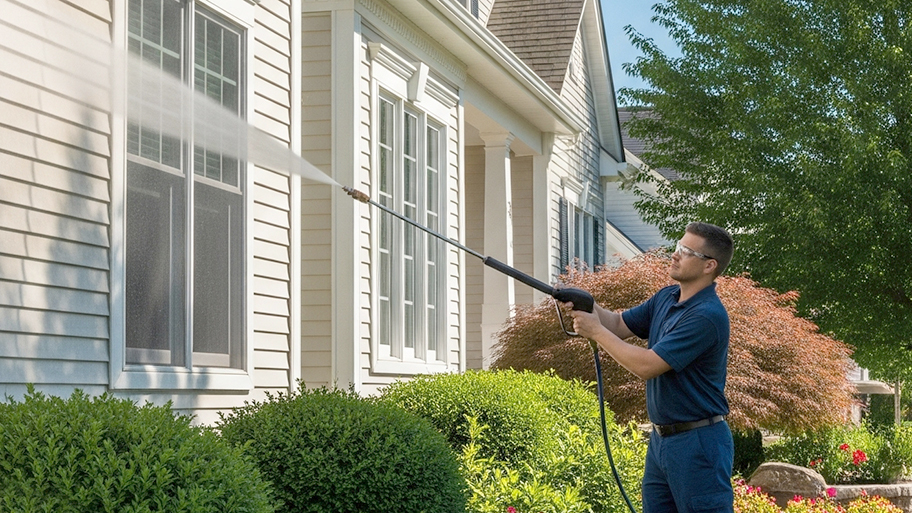
Need to breathe new life into your dirty siding and trim? Explore the cost to pressure wash a house to boost your curb appeal instantly.
Your newly cleaned patio will be perfect for summer dining


Patios are the perfect place to sit with friends and family, scarf down meals, and jam some serious tunes. They are also magnets for dirt, food debris, mold, bird droppings, and just about everything else. That’s why many people turn to power washers to quickly and efficiently clean their patios. Here’s the step-by-step process to power wash your patio, along with some crucial safety tips.
First, get your hands on a pressure washer or power washer. What’s the difference? Pressure washers use cold water, and power washers use hot water—depending on the material of your patio, either option should work. Just be careful, as power washers can do some serious damage to tiles or painted surfaces.
Most hardware stores rent these tools out for $35 to $175 per day. Buying one costs anywhere from $100 to $2,000, with power washers being more expensive than standard pressure washers. Choose a model with multiple pressure settings, as you want to work with the lowest setting that gets the job done to protect you from accidental damage. You also want to move furniture and fixtures from the patio before starting.
To fully appreciate the magic of power washing before and after results, you want to avoid accidentally drenching and damaging nearby fixtures or landscaping. Cover up any electrical outlets, plants, AC ports, and anything else you don’t want to be cleaned. Use tarps or large plastic bags, tying them off with rubber bands. Do the same with windows, trim, doorways, and any other exposed openings.

Pressure washers and power washers both create intensely-focused streams of water that can cause personal injury or property damage. Gear up to protect yourself. Cover up exposed skin, wear safety glasses, and avoid open-toed shoes. Never direct a power washer at any living thing: Keep the spray far away from plants, animals, and children.
Now it’s time to add a cleaning agent if you need it. Some washers boast integrated capsules or chambers for detergent. If not, just spray or wipe the detergent directly onto the patio surface. Make sure the detergent you choose matches the materials that comprise your patio and is designed to be used with a power washer.
Using detergent in the first place is a personal judgment call and largely depends on how dirty your patio is and what machine you are using. Pressure washers nearly always benefit from detergent, but power washers can get by with just water due to the increased heat. Even power washers require a detergent, however, if you are removing tough stains and a significant buildup of grime.

Now the fun part. Power on that washer and get going, but follow proper cleaning methods. If washing a wood patio, follow along the grain and not across it to avoid splinters. Generally speaking, spray at a downward angle to avoid accidental damage and use broad, sweeping motions. Direct the stream into cracks and crevices between bricks or paving stones to clear out debris. The most important tip, however, involves pressure. Start at the lowest pressure setting available and move up only when necessary.
Once you complete the power washing stage, it’s time to remove any icky detergent residue. Use a standard garden hose and go to town. Make sure you not only rinse off the patio itself but also anything downstream from it. The soap has to go somewhere, after all.

If any stains linger even after the power washing process, spot-clean these areas with a sponge or wire brush, water, and the appropriate spray detergent. Use the sponge for surface debris and move to the wire brush for tougher stains. The brush is also great for cracks and crevices. If you notice any green or black growth, that’s mold, so mix up some bleach with your cleaning solution and wipe it away.
After you finish, allow the patio to dry for a day or two before moving any fixtures or furniture back in place.
Using a power washer takes plenty of experience, so only attempt this job if you’ve put in some time cleaning with pressurized water. If you don’t feel completely comfortable with your skill level, hire a local pressure washing company to pressure wash a patio for you. Making a mistake with a power washer or pressure washer can lead to property damage and, in rare cases, personal injury. If you do have the time and experience, the deciding factor may be the cost. Depending on local rental costs, you may not even save too much money by going the DIY route. Hiring a pro to power wash your home costs $0.10 to $0.50 per square foot, so measure your patio and compare that cost range to hardware rental prices.
From average costs to expert advice, get all the answers you need to get your job done.

Need to breathe new life into your dirty siding and trim? Explore the cost to pressure wash a house to boost your curb appeal instantly.

Pressure washers can help you keep your home looking great. Use this guide to learn how much it costs to rent a pressure washer based on factors like type and time.

Pressure washing your fence can restore its appearance and keep your home looking great. Learn how much it costs based on factors like square footage and material.

PSI measures water pressure in pounds per square inch. GPM measures water flow rate in gallons per minute. Learn more about the difference.

What is pressure washing? It’s a quick way to get rid of built-up stains—but only under the right circumstances. Here’s when (and when not) to pressure wash.

Safely pressure wash your shower or bathtub without damaging your caulking, fixtures, and tiles. Choose the best nozzle and equipment for your needs.